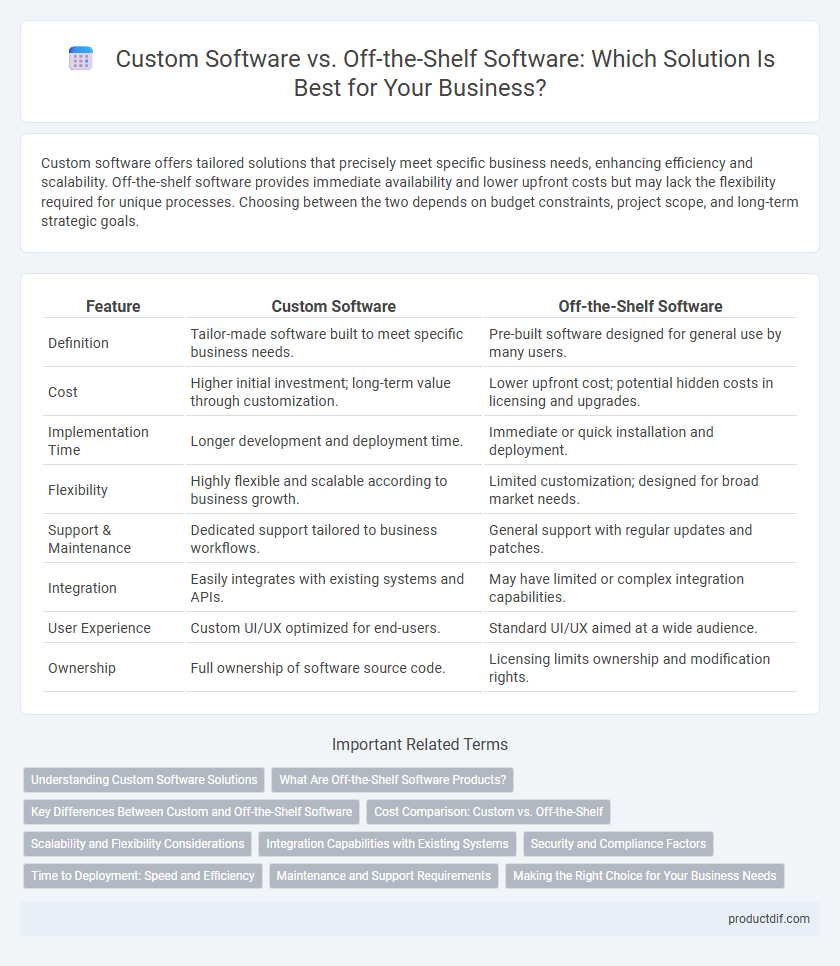Custom software offers tailored solutions that precisely meet specific business needs, enhancing efficiency and scalability. Off-the-shelf software provides immediate availability and lower upfront costs but may lack the flexibility required for unique processes. Choosing between the two depends on budget constraints, project scope, and long-term strategic goals.
Table of Comparison
| Feature | Custom Software | Off-the-Shelf Software |
|---|---|---|
| Definition | Tailor-made software built to meet specific business needs. | Pre-built software designed for general use by many users. |
| Cost | Higher initial investment; long-term value through customization. | Lower upfront cost; potential hidden costs in licensing and upgrades. |
| Implementation Time | Longer development and deployment time. | Immediate or quick installation and deployment. |
| Flexibility | Highly flexible and scalable according to business growth. | Limited customization; designed for broad market needs. |
| Support & Maintenance | Dedicated support tailored to business workflows. | General support with regular updates and patches. |
| Integration | Easily integrates with existing systems and APIs. | May have limited or complex integration capabilities. |
| User Experience | Custom UI/UX optimized for end-users. | Standard UI/UX aimed at a wide audience. |
| Ownership | Full ownership of software source code. | Licensing limits ownership and modification rights. |
Understanding Custom Software Solutions
Custom software solutions offer tailored functionality designed to meet specific business processes and unique operational requirements, providing greater scalability and flexibility compared to off-the-shelf products. These solutions often integrate seamlessly with existing systems and enable organizations to maintain competitive advantage through bespoke features not available in standard software packages. Investing in custom software minimizes unnecessary features and optimizes performance by aligning the technology closely with company goals and workflows.
What Are Off-the-Shelf Software Products?
Off-the-shelf software products are pre-built applications designed to meet the general needs of a wide range of users or businesses, offering immediate availability and lower initial costs compared to custom software. These products, such as Microsoft Office, Adobe Photoshop, and QuickBooks, come with standard features and updates managed by the vendor, providing ease of use and reliability without the need for extensive customization. While off-the-shelf software supports common functionalities, it may lack the flexibility to address unique or evolving business requirements that custom software solutions can offer.
Key Differences Between Custom and Off-the-Shelf Software
Custom software offers tailored features designed to meet specific business requirements, ensuring greater flexibility and scalability. Off-the-shelf software provides standardized solutions with quick deployment but lacks customization, often leading to potential limitations in functionality. Cost efficiency and update frequency also vary, with custom software incurring higher initial costs but offering long-term adaptability compared to subscription-based off-the-shelf options.
Cost Comparison: Custom vs. Off-the-Shelf
Custom software generally involves higher initial development costs due to tailored design, unique features, and dedicated support, while off-the-shelf solutions offer lower upfront expenses with subscription or licensing fees. Long-term costs for custom software can be more economical as it eliminates unnecessary features and reduces dependency on vendor updates. Off-the-shelf software may incur additional expenses through customization, integration, and ongoing upgrades that are not included in the base price.
Scalability and Flexibility Considerations
Custom software offers superior scalability and flexibility, allowing businesses to tailor applications precisely to their evolving needs and integrate new features without limitations. Off-the-shelf solutions may provide faster deployment but often lack the capacity for deep customization and can struggle to scale efficiently as organizational demands grow. Investing in custom software development ensures adaptability and long-term performance aligned with specific operational requirements.
Integration Capabilities with Existing Systems
Custom software offers superior integration capabilities with existing systems by allowing tailored development that aligns precisely with unique business processes and legacy infrastructure. Off-the-shelf software often requires extensive customization or middleware to connect with current systems, which can lead to increased compatibility issues and higher long-term costs. Seamless integration in custom solutions ensures better data flow, enhanced operational efficiency, and reduced risk of system conflicts.
Security and Compliance Factors
Custom software offers enhanced security and compliance by allowing tailored implementation of industry-specific protocols and regulatory requirements, minimizing vulnerabilities linked to generic solutions. Off-the-shelf software often includes standard security features, but may lack the flexibility to fully address unique compliance mandates, increasing risk exposure in sensitive environments. Organizations handling critical data frequently prefer custom development to ensure robust encryption, access controls, and audit trails aligned with frameworks like GDPR, HIPAA, or PCI-DSS.
Time to Deployment: Speed and Efficiency
Custom software development typically involves longer time to deployment due to tailored design, coding, and testing processes specific to business requirements. Off-the-shelf software offers rapid deployment since it is pre-built, tested, and ready for immediate implementation, significantly reducing time-to-market. Businesses prioritizing speed and efficiency often choose off-the-shelf solutions, while those requiring specialized functionality may invest in custom software despite longer development cycles.
Maintenance and Support Requirements
Custom software requires tailored maintenance and dedicated support teams to address unique system updates and bug fixes, ensuring alignment with specific business needs. Off-the-shelf software offers standardized maintenance with vendor-provided support, but may lack flexibility in addressing specialized issues or customizations. Choosing between the two depends on balancing ongoing support costs with the need for adaptable and scalable software solutions.
Making the Right Choice for Your Business Needs
Choosing between custom software and off-the-shelf solutions hinges on aligning features with your business requirements and scalability goals. Custom software offers tailored functionality and flexibility, ideal for unique workflows and long-term growth, while off-the-shelf products provide cost-effective, quick deployment options with standardized features. Evaluating factors such as integration capabilities, budget constraints, and maintenance plans ensures the optimal software decision that maximizes operational efficiency and competitive advantage.
Custom software vs Off-the-shelf Infographic

 productdif.com
productdif.com